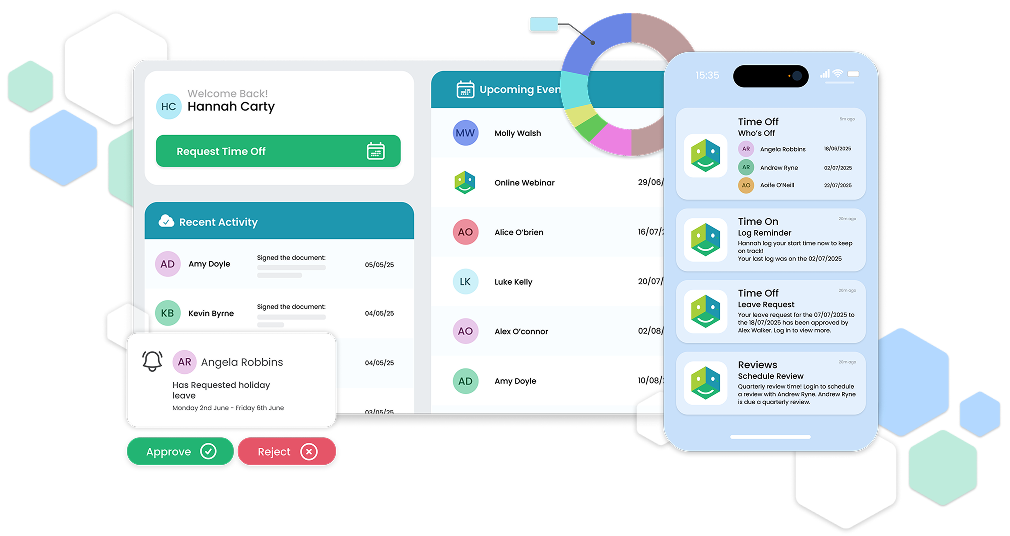The annual performance review has long been a staple in performance management practices. Not because it worked – but because businesses didn’t know what to do instead.
Fortunately, people are wising up to a better alternative – continuous performance management, which is a yearly conversation for daily practices.
Let’s explore how a continuous feedback culture can work for your business.
Organisational Culture and Employee Performance
Performance management demands openness and honesty from leaders and teams.
Leaders need to be constructive and truthful when providing feedback. Individual employees need to be honest about the opportunities and obstacles they face.
Organisations can’t achieve this level of trust and transparency without psychological safety. Making sure your people feel supported, empowered, trusted, and respected will help them open up about their experience and take feedback on board.
In a communicative culture, it’s easier to set clear expectations. Individuals will soon pipe up if something doesn’t make sense. If your teams feel safe, they’ll be more inclined to take calculated risks and think innovatively. Psychological safety isn’t just about performance, though – it’s about wellbeing.
Leaders must make space for sensitive conversations, as well as provide judgment-free zones. Displays of vulnerability from leaders will demonstrate to teams that it’s okay if things don’t go to plan. In regular check-ins, encourage everyone – regardless of their seniority – to share what they’re struggling with.
It’s important to make sure ‘feedback’ isn’t synonymous with ‘criticism’ in your organisation. Use your regular check-ins and team meetings to deliver positive feedback and recognise what went well, too. As important as it is to dissuade employees from the things that don’t work, you also need to encourage the things that do.
Real-Time Performance Feedback
In the last few years, generative AI has taken the world by storm. Although many companies were already experimenting with the technology, it’s safe to say the rate of adoption has been unprecedented for most.
Given the pace of change in businesses today, feedback needs to be delivered and actioned quickly for it to have an impact. Real-time feedback helps businesses move with the times by taking an iterative approach to performance and development.
Of course, people also need to be able to deliver feedback constructively. Providing training for your teams can help them feel more confident with the process.

You can also improve the quality of real-time feedback in your business with supporting software and apps. Platforms that enable the collection and analysis of performance metrics will help your leaders pinpoint who needs support. Collaborative tools that enable leaders and team members to review each other's work can help you assess performance at all levels.
But real-time feedback isn’t just about what happens between leaders and their teams. Research has shown that peer feedback also boosts employee performance. In supportive teams, peer feedback may happen organically. But you can also embed it into your performance management practices, through team meetings and peer-review processes.
Set SMART Performance Goals
Team goals set the tone for the months and years ahead. There are a few things you can do to elevate your approach to goal setting and align your teams with organisational priorities.
Start with SMART goals. Make sure you’re setting targets that are:
- Specific
- Measurable
- Achievable
- Relevant
- Time-bound
The benefit of SMART goals is their clarity. It’s much harder for employees to deliver what you want if your expectations are poorly defined.
Don’t overlook the value of collaborative goal setting, either. Your people may be able to see their unique strengths and weaknesses in greater detail than you, so talk with them to unearth goals that energise and challenge them.
Whether your goals are weekly, monthly, or quarterly, checking in regularly is essential. Circumstances and dependencies change. Plus, you might find that individuals need an extra steer or support to get things right. It’s important not to be too rigid. Recognise the need to adjust goals when things change—because they almost certainly will.
Personal goals matter, but equally important are the collaborative ones. Having shared goals is a reminder that everyone is working towards a common mission, which can help with your team’s sense of purpose and connection to each other.
Employee Development Best Practices
Development plans should be personalised, tailored, and collaborative. Work with your people to outline their career aspirations, identify their learning requirements, and establish how they learn best.
Training and learning opportunities should also be personalised to employee learning styles and requirements and aligned with organisational goals. Provide multiple formats and educational resource types to support your team’s individual needs – think workshops, online courses, and practical activities.

You might also use mentoring and coaching as part of your development practices. This can be a great way to make the most of the more experienced people in your company and pass on skills that are harder to find in the talent pool.
You don’t even need to focus employees on one area of development. In light of a constricted talent market and tight budgets, cross-training is facing a resurgence. And there are benefits for everyone; your people get both a more varied workload and the opportunity to develop new skills. Businesses benefit from employees who can move around different specialisms as and when skills gaps arise.
Employee Recognition and Rewards
So far, we’ve explored how you can challenge your people, support their growth, and stimulate their curiosity through learning and development.
Now it’s time to discuss how you should celebrate them. Recognition and rewards are an integral part of performance management, and companies that overlook this are failing to support their employees’ emotional needs.
It all starts with clear performance metrics. Setting SMART goals will help your people understand what’s expected of them and put that into action. It tells your people what you value as a company, and gives them clues as to how they should act within that framework.
Next, you need to be on time. Every time. Don’t withhold compliments and rewards until the next big event. Celebrate your people in the moment. Immediate recognition reinforces desired behaviours. Your team can only do more of the good stuff if they know what the good stuff is.
Not everyone likes to be recognised in the same way. Some people prefer private acknowledgement, whereas others enjoy public celebration. Chat with your team members individually and take note of their preferences. This way, rewards won’t accidentally come across as something to dread.
Recognition can and should be a team-wide initiative. Encourage the whole team to recognise and reward their colleagues’ achievements through a peer nomination programme
Build a Continuous Feedback Culture
With the strategies outlined above, you have the beginnings of a continuous feedback culture.
A continuous feedback culture prioritises real-time feedback between all team members. The annual performance review is replaced by frequent informal discussions and feedback sessions. Specific, actionable, and timely feedback is the priority.
This approach to feedback is more aligned with modern approaches to work. For starters, the younger generation wants more feedback from their employers, and can’t rely on the office osmosis of information to help them learn. The talent market has changed dramatically too. It’s much harder to find talent, making it all the more important for businesses to get the best out of their existing teams. Plus, businesses are in a constant state of flux, and regular feedback keeps people aligned with organisational changes.
The technology to support continuous feedback is well-established, too. There are countless ways to collect and analyse performance data, and teams should be putting this to good use.









